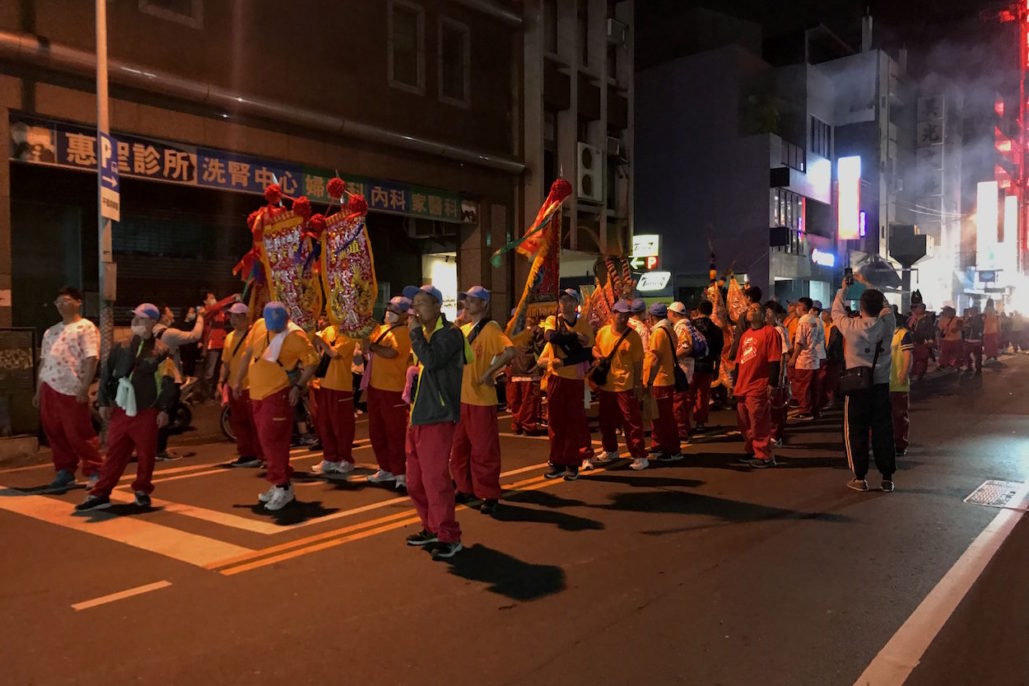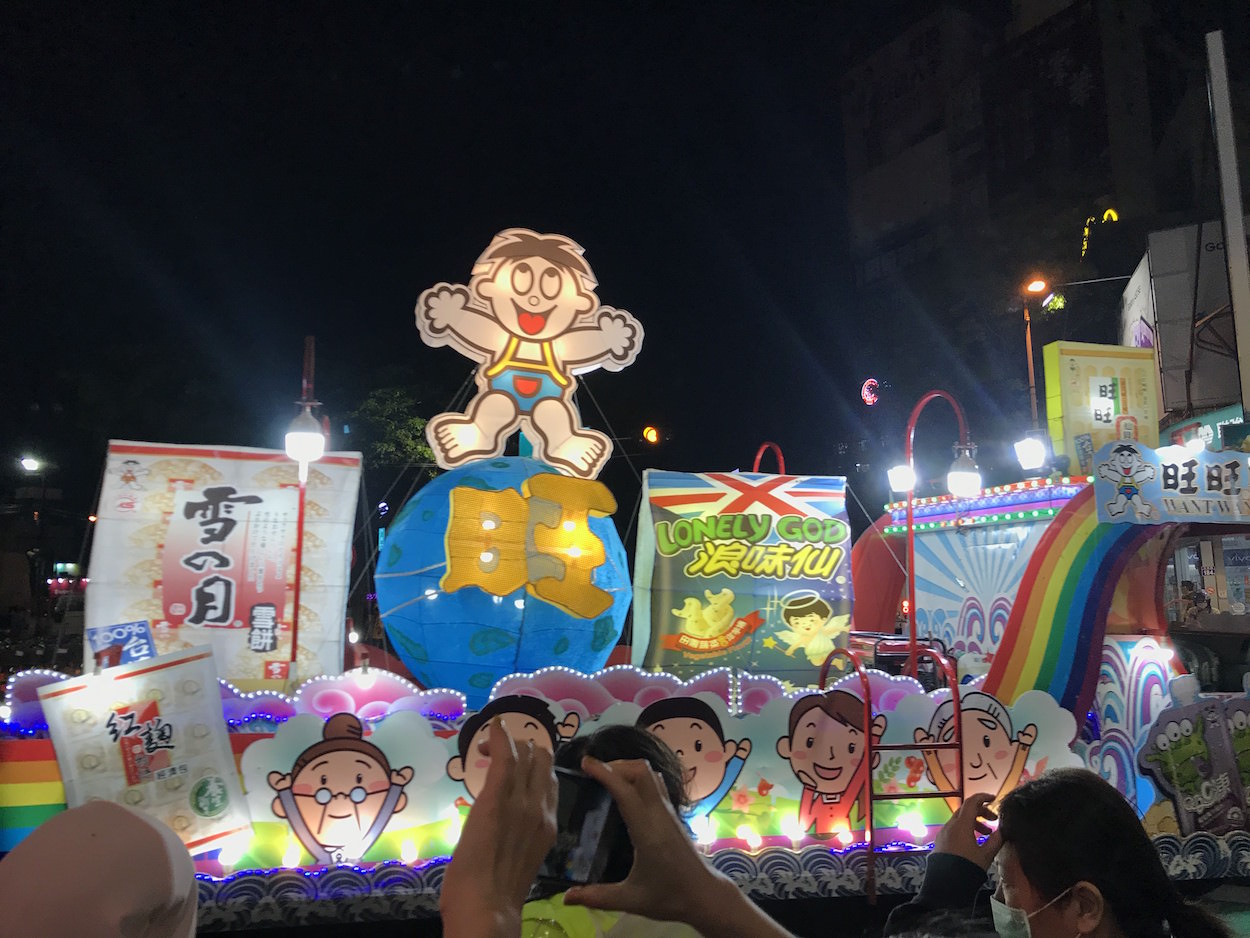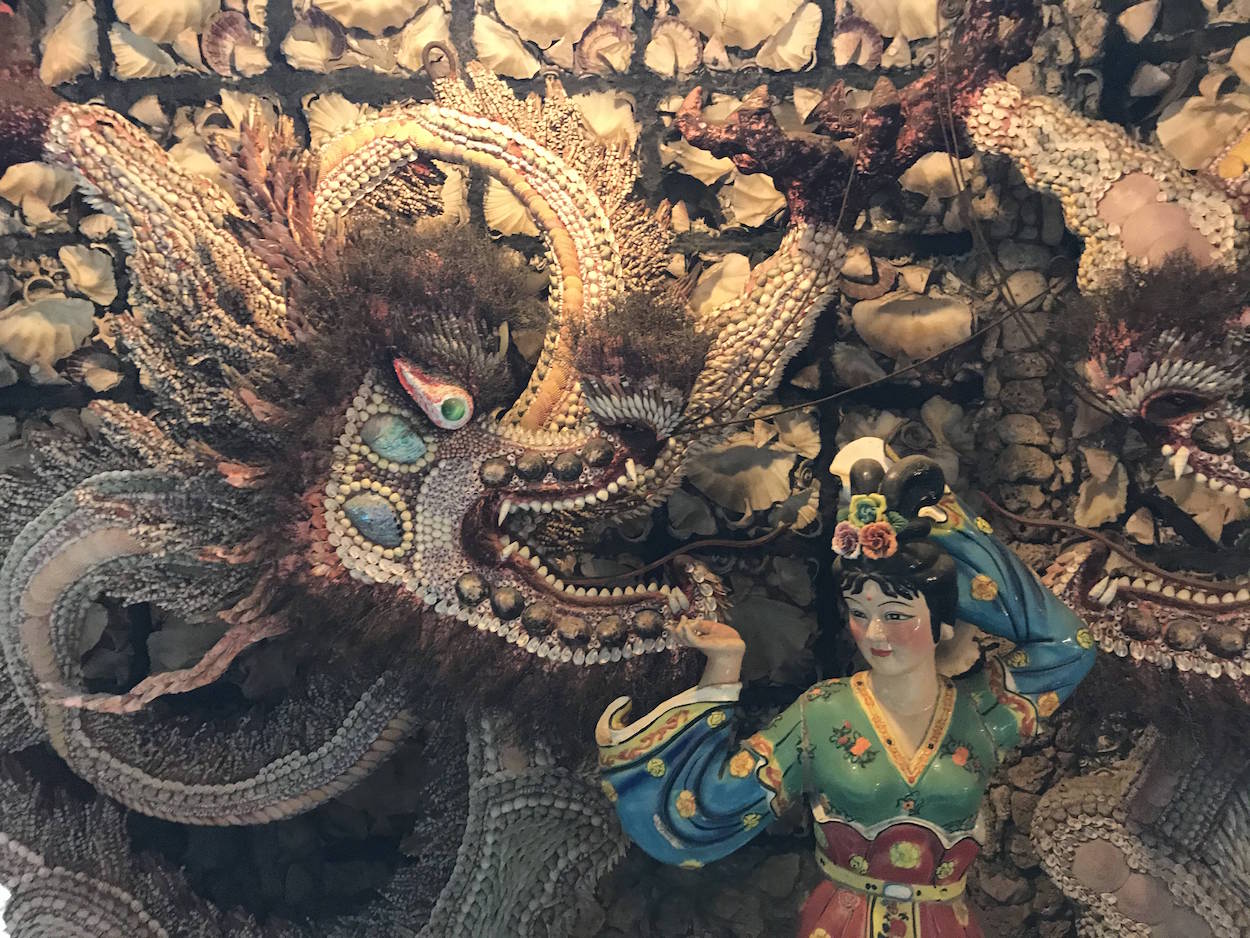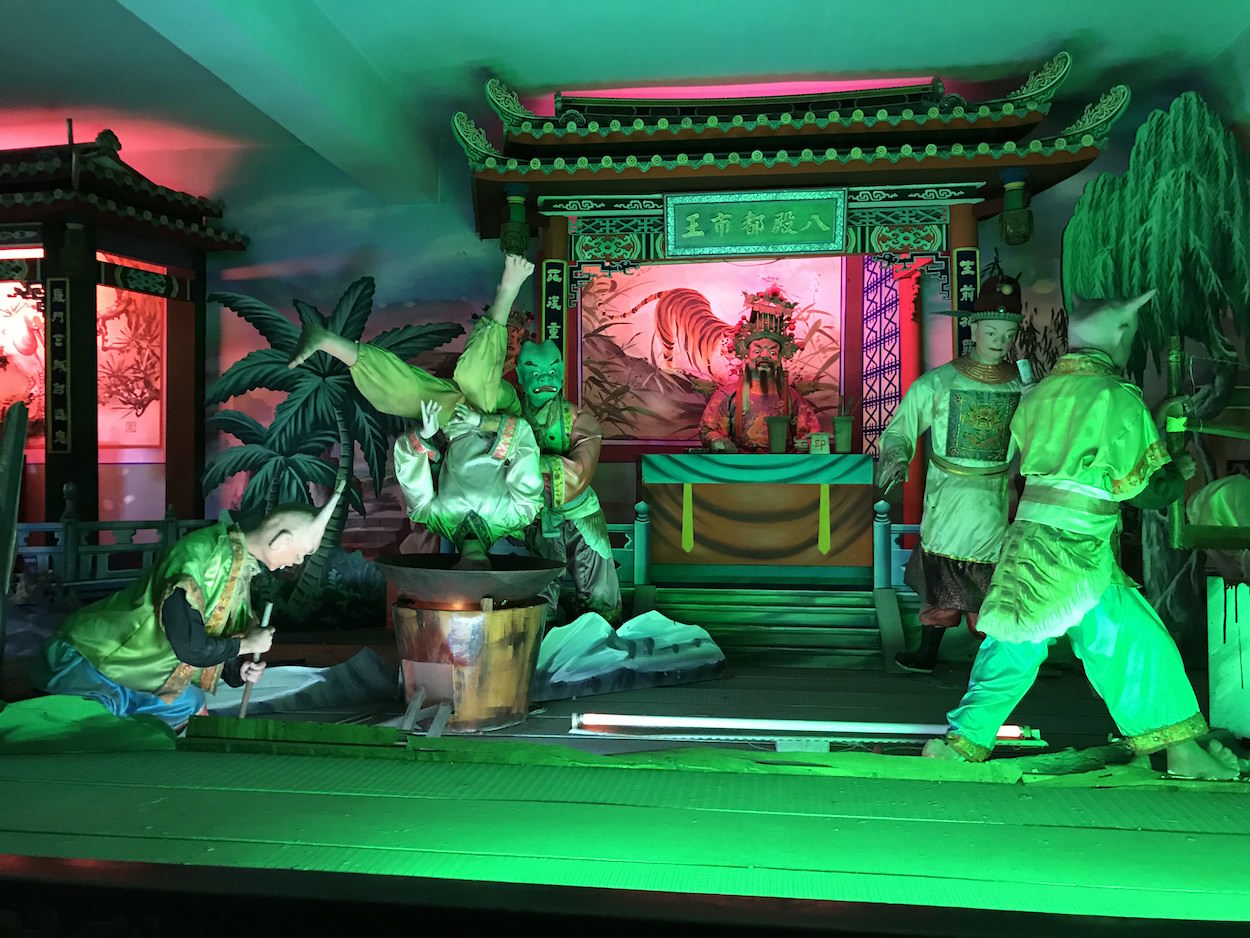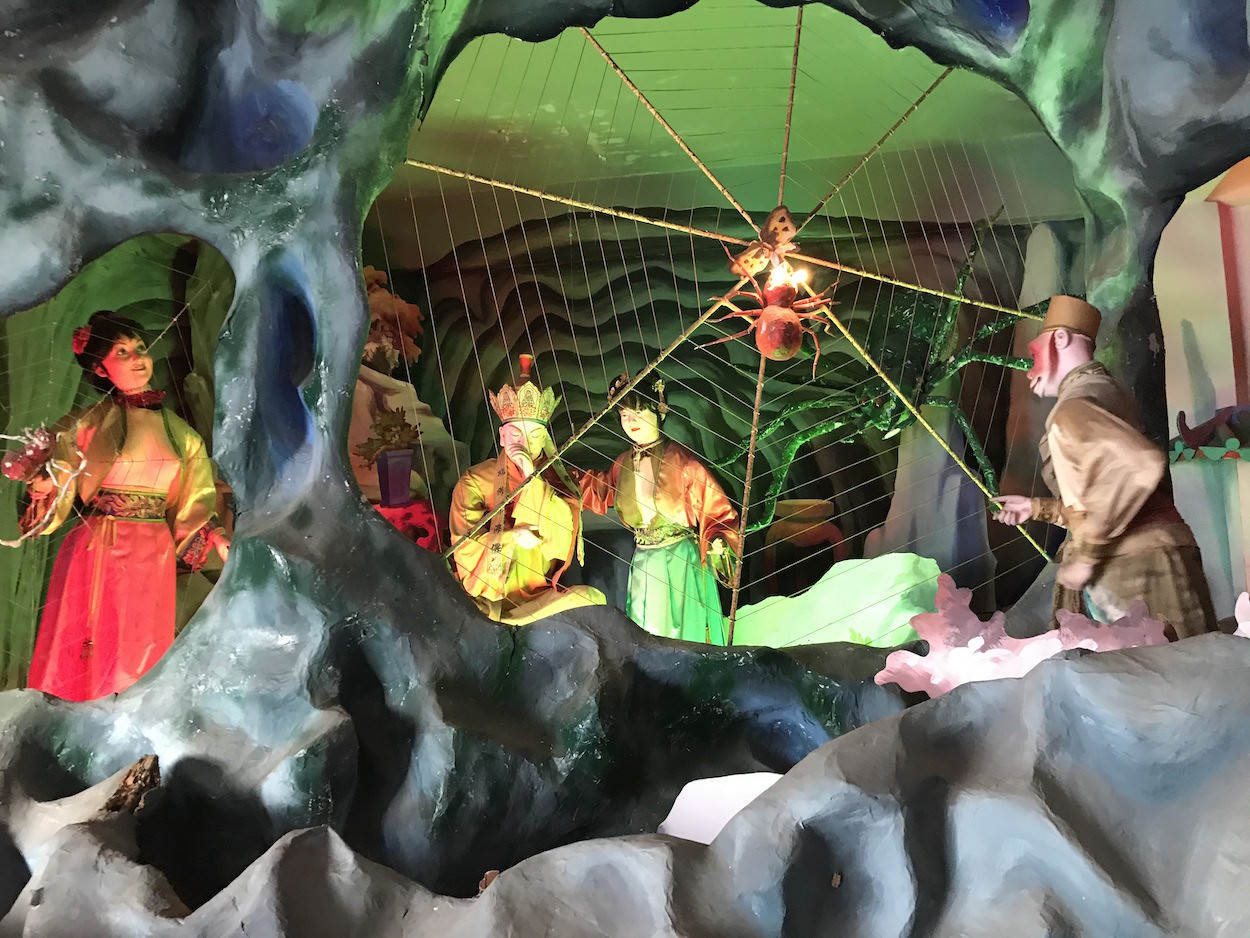by Brian Hioe
語言:
English
Photo Credit: Brian Hioe
TEMPLE FESTIVALS in Taiwan often seem to be a mixture of the sacred and the profane. Sure, temples are places of worship—but temple festivities often have elements of what would otherwise be considered “low” culture incorporated into them. Temple festivals historically were considered working-class culture, rather than sanctified, elite culture, which is probably a key part of it.
So, it’s not uncommon in Taiwan that you might see pole dancers, electronic music, gaudy LED lights, or even Japanese anime-themed “itasha” cars at temple festivals. Part of this probably reflects the interests of the young people part of temple troupes, who incorporated what they were interested into temple festivals.
Corporate floats at the Dajia Mazu pilgrimage: Kinmen Kaoliang, Foodpanda, and the Want Want Group. Photo credit: Brian Hioe
Last week, I ventured to the Dajia Mazu festival, the largest religious festival in Taiwan. Consisting of a nine-day journey from Dajia to Chiayi, then back—some 360 kilometers—it draws over one million worshippers through the course of the festival.
Mazu is probably Taiwan’s most important deity; seeing as Taiwan is an island nation, it may not be surprising that Mazu is a sea deity. Born as Lin Mo in 960 AD, Lin Mo was deified after death in 987 AD, and became the sea goddess Mazu. Mazu is worshipped not only in Taiwan, but coastal provinces of China. Each temple devoted to Mazu has its own Mazu statue, which goes on tour to other temples as part of religious pilgrimages—the Dajia Mazu pilgrimage consists of the Mazu from the Dajia Jenn Lann Temple traveling to the Fengtien Temple in Chiayi.
Mazu herself (top) and Sun Wukong (bottom), passing by in their palanquins. Photo credit: Brian Hioe
Last year’s festival was postponed by several months due to COVID-19, with celebrations scaled-down and real-name registration required at temples. But there have only been over 1,000 COVID-19 cases in Taiwan and eleven deaths to date because of the coronavirus, due to the swift government response. So the pilgrimage could go on—organizers claimed that over one million participated in the event—which I’m not sure I actually believe. The King Tsingshan Festival in my local neighborhood of Bangka, another one of Taiwan’s major festivals, actually seemed larger to me this year.
Organizers then later claimed that six million were in attendance—which would be one out of four people in Taiwan. Not likely. But there was still sizable participation nonetheless.

Photo credit: Brian Hioe
In any case, the tone for this year’s celebration was still more muted than usual. As it is believed to be auspicious for the palanquin carrying Mazu to pass over worshippers, worshippers often fight to have the palanquin pass over them. Otherwise, temple groups will try to divert the procession and seize the palanquin to keep Mazu in their territory, because this is also believed to be auspicious.
An overpass in the city of Changhua, the only major populated urban area that the pilgrimage passes through, proves a particular site of contestation. In past years, organized crime groups have sometimes fought to have the Mazu palanquin pass over their leaders, resulting in hundreds of riot police being deployed to prevent this from happening. Though no such struggle broke out this year, hundreds of riot police were still deployed in case this happened—large groups of uniformed police wandered around and shifted around barriers throughout the duration of the pilgrimage’s time in Mazu. Worshippers did lay under the palanquin at the pilgrim’s completion as it returned to Taichung, though.
Changhua Seashell Temple, with live alligators and turtles! Photo credit: Brian Hioe
There’s a political dimension to this, too. The Dajia Mazu pilgrimage is considered more affiliated with the KMT and pan-Blue camp and the head of the Jenn Lann Temple where the pilgrimage starts, Yen Ching-piao, is well known as a gangster. It is well-known in Taiwan that temple culture often has a gang element. The Dajia Mazu pilgrimage organizers have tried to push for religious pilgrimages to visit China in the past, so as to remind that Mazu is originally a Chinese goddess—in line with the pro-unification views of the pan-Blue camp.
By contrast, the DPP is more affiliated with the rival Baishatun Mazu pilgrimage, which begins in Miaoli. The Baishatun Mazu pilgrimage is known as the longest religious pilgrimage in Taiwan, having an unpredictable route that is determined randomly by the swaying of the palanquin—sometimes resulting in odd events such as Mazu visiting a supermarket or deciding to take a swim in a river.

Mount Bagua Buddha Temple. Photo credit: Brian Hioe
Oftentimes, you’ll have worshippers traveling to cities and waiting for the palanquin to arrive along the parade route or catching up with the palanquin after catching up. You’ll often be able to recognize them from the temple flags that they carry on them. There will be supply stations and tents set up for locals to provide them with food and night market-like stalls will be set up to sell food or souvenir items. There’s a veritable economy of its own for religious pilgrimages, between the companies that produce such souvenirs and the merchants that sell them, the troupes of dancers that travel between temple festivals to perform, the singers, DJs, and other performers that play at festivals.
And technology has made things much simpler for pilgrimages. These days, Mazu has a GPS locator attached to the palanquin and an app for locating her along the parade route, making finding her much simpler—although at least the app for the Dajia Mazu pilgrimage was very buggy and often glitched. Mazu’s on Instagram, too, with custom filters for displaying a Mazu image above the heads of people you photograph or displaying a Mazu-themed baby pacifier—a throwback to the integration of temple culture and raves that took place in the 1990s and early 2000s, with phenomena such as the Electric Techno Neon-Gods.
Animatronic hell at the Nan Tien Temple. Photo credit: Brian Hioe
All this makes me think about the cyborg nature of many contemporary deities in Taiwan today, perhaps. While I was in Changhua for the pilgrimage, I visited a number of temples featuring odd technological accouterments for the divine. I saw crane claw machines at the Mount Bagua Buddha Temple and a glowing LED light in the forehead of the five-story tall Buddha itself, which has modern windows in the back. I saw two floors of schlocky animatronic depictions of hell at the Nan Tien Temple, which must have looked state-of-the-art in the 1970s, but now consist of animatronics that wave their arms awkwardly at you. I saw a Mazu shrine made of glass, this being the pet project of the CEO of a glassmaking company that decided to build a shrine to Mazu next to a museum about glassmaking, probably as some kind of legacy thing. I saw another temple constructed entirely out of seashells, apparently one man’s passion project, with live alligators and turtles.
The sacred intersects, then, not only with the profane but also the highly secular or mundane. Or so you’d think, anyway, except for the embeddedness of religion in everyday life—rather than as some far-removed realm of the sacred.


